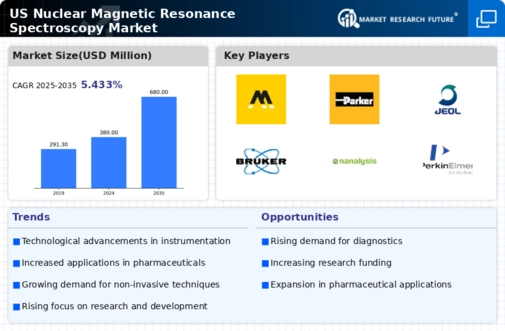Expansion in Academic Research
The nuclear magnetic-resonance-spectroscopy market is benefiting from an expansion in academic research initiatives across various scientific disciplines. Universities and research institutions are increasingly investing in NMR technology to facilitate groundbreaking studies in chemistry, biology, and materials science. In 2025, funding for academic research in the US is expected to reach $80 billion, with a substantial portion earmarked for advanced instrumentation. This influx of funding is likely to enhance the capabilities of laboratories, thereby increasing the adoption of nuclear magnetic-resonance-spectroscopy. The ability to conduct detailed molecular analysis positions NMR as a vital tool in academic settings, fostering innovation and discovery.
Rising Demand in Pharmaceutical Research
The nuclear magnetic-resonance-spectroscopy market is experiencing a notable increase in demand driven by the pharmaceutical sector's need for advanced analytical techniques. As drug development becomes more complex, the ability to analyze molecular structures and interactions is paramount. In 2025, the pharmaceutical industry in the US is projected to allocate approximately $50 billion towards research and development, with a significant portion directed towards spectroscopy technologies. This trend indicates a robust growth trajectory for the nuclear magnetic-resonance-spectroscopy market, as it provides critical insights into drug formulation and efficacy. Furthermore, the integration of NMR spectroscopy in quality control processes enhances the reliability of pharmaceutical products, thereby reinforcing its importance in the industry.
Growing Interest in Food Safety and Quality
The nuclear magnetic-resonance-spectroscopy market is poised for growth due to the increasing emphasis on food safety and quality assurance. Regulatory bodies in the US are tightening standards for food products, necessitating advanced analytical methods to ensure compliance. NMR spectroscopy offers a non-destructive means of analyzing food composition, detecting contaminants, and verifying authenticity. As consumers become more health-conscious, the demand for high-quality food products is rising, prompting manufacturers to adopt sophisticated testing methods. The market for food safety testing is projected to grow at a CAGR of 7% through 2025, indicating a favorable environment for the nuclear magnetic-resonance-spectroscopy market to thrive.
Increased Investment in Healthcare Diagnostics
The nuclear magnetic-resonance-spectroscopy market is experiencing a surge in investment driven by the growing need for advanced healthcare diagnostics. As the US healthcare system shifts towards personalized medicine, the demand for precise diagnostic tools is escalating. NMR spectroscopy plays a crucial role in biomarker discovery and disease characterization, making it an invaluable asset in clinical settings. In 2025, healthcare spending in the US is projected to exceed $4 trillion, with a significant portion allocated to diagnostic technologies. This trend indicates a robust growth potential for the nuclear magnetic-resonance-spectroscopy market, as healthcare providers seek to enhance patient outcomes through innovative diagnostic solutions.
Technological Integration with Artificial Intelligence
The nuclear magnetic-resonance-spectroscopy market is likely to witness transformative changes through the integration of artificial intelligence (AI) technologies. AI can enhance data analysis capabilities, enabling faster and more accurate interpretation of NMR spectra. This synergy between NMR and AI is expected to streamline research processes in various sectors, including pharmaceuticals and materials science. As organizations seek to improve efficiency and reduce time-to-market for new products, the adoption of AI-driven NMR solutions is anticipated to rise. The potential for AI to revolutionize data processing in the nuclear magnetic-resonance-spectroscopy market suggests a promising future for stakeholders in this field.





















Leave a Comment